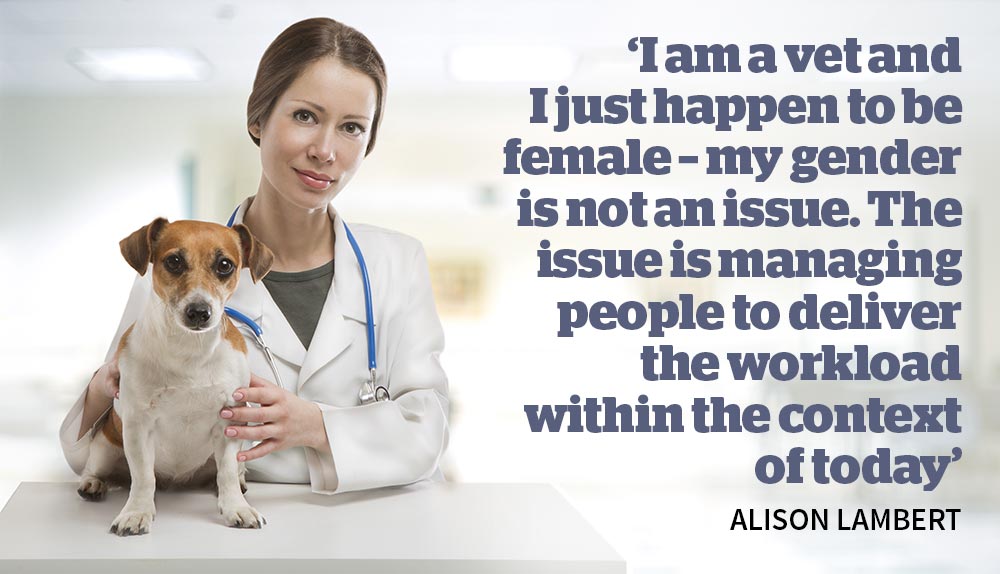6 Mar 2018
While data reveals 57% of new graduates were female in 1994, fast forward 20 years and that disparity had increased significantly, with women making up more than three quarters of graduate output. It doesn’t take a statistical genius to conclude that in a few decades time the vast majority of the veterinary profession – at all levels and locations – will be staffed by women…

 The gender balance in the UK veterinary profession has been a source of debate in recent years.
The gender balance in the UK veterinary profession has been a source of debate in recent years.
Almost every congress and conference worth its salt hosts streams and discussion groups focused on the dynamics of an increasingly female-dominated workforce.
These dynamics are complex and often interconnected; ranging from the need for more female leaders in veterinary business and increased flexibility for working mothers, to broadening access and creating more rewarding career structures.
In some quarters this feminisation has been presented as a problem to be overcome. However, a growing number see it as an opportunity to give the model of private practice in the UK a much-needed overhaul.
We asked our Big 6 panel to discuss some of these dynamics, and here are the results…
Nature dictates women have the children, while entrenched attitudes in society still dictate these same women will also be the main source of care for those children.
 For a start, the healthy margins made on veterinary medicines and product sales have come under increasing pressure from internet vendors with little or no overheads. Another vitally important factor is a lot more practices exist than used to.
For a start, the healthy margins made on veterinary medicines and product sales have come under increasing pressure from internet vendors with little or no overheads. Another vitally important factor is a lot more practices exist than used to.
This means an increasingly large percentage of vets and VNs require (and will continue to require) career breaks and flexible working hours to ensure a sustainable future for the delivery of animal health care.
The implications of this – and for the way veterinary practice works now and in the future – are significant, and our Big 6 panel spent many hours discussing these; discussions that, in the end, fell under three broad headings: flexible practice, managing without men and changing attitudes.

Vet and owner of Broad Lane Vets in Coventry Elly Pittaway said whether the profession should be as female as it is is “a matter of another debate”, but, from her experience, practices have had to adapt to cope with part-time and flexible working over the past 10 years, and “will need to continue to do so”.
“Our practice embraces this, though others I hear of appear to be rather more resistant,” she said. “However, we do seem to be seeing a paradigm change in people’s expectations of work-life balance in all walks of life, not just veterinary – so, ignore it at your peril.”
Elly’s practice offers flexible working for all sorts of reasons, she said. “[It’s] not just childcare – [there are] sabbaticals for voluntary work and sports training, short hours for those with disabilities, compressed hours for those with commitments/hobbies on a regular day each week, and, increasingly, requests to work short hours/less days just so they can have more ‘me’ time. Unfortunately, too, it seems most people with kids want time together with them and their other half in the evenings, and at the weekend still. The occasional ad I’ve put in the veterinary press for weekend-only workers has received very little response, so I’ve given up and work most Sundays myself now.
“However, we make our Krypton Factor rota work by ensuring everyone does a ‘fair’ share of late week nights and weekends, even if they only work a couple of days a week, and/or finish early on one or more weekdays. It isn’t easy to manage, and I do think we inevitably compromise on continuity, but, overall, we are open for far longer hours than our predecessors – owners these days can’t leave work so easily to get their pet to the vet, meaning most of us offer appointments until at least 6:30pm.
“If an owner complains to me about seeing a different vet, I do (politely) point out to them we are open nearly 80 hours a week, so even the full-time vets can’t be here all day every day. We also make clear to our vets they must do their best to provide continuity, and will mostly book routine things back in with themselves or ‘share’ a case with a named colleague, who they will introduce to the client where possible. This helps manage client expectations and – currently – works well for us.”
For vet and Onswitch managing director Alison Lambert, flexibility comes down to good workload planning.
“I think we are focusing on half the issue and flexible working is normal for lots of varied reasons,” she said. “So, how do we deliver a service with a flexible changing workforce?
“The model of vet teams working 50 to 60 hours a week has gone for the majority, so, for me, planning is key – what needs to be done, by when, and by what skill set?
“I am a vet and I just happen to be female – my gender is not an issue. The issue is managing people to deliver the workload within the context of today. There are other sectors that have female-male workforce percentage splits like ours and it all works fine, although nothing is ever perfect – that is reality.”
Professor of general practice at the RVC, Jill Maddison’s contribution to this particular debate proved to be something of a reality check, as she discussed changing attitudes towards work in recent decades.
“I agree the issue now isn’t gender per se, but the trend in modern society for many people to want to work flexibly – for child care needs, other family caring needs (the squeezed generation) or life balance,” she said. “However, the reality is requests for flexible working are still driven by child care needs in most workplaces. Parental leave is open to all, but in our experience at the RVC, it is rarely taken up by the fathers and overwhelmingly it is the mother who opts to work part-time once children arrive.
“For the system to work for everyone – patients, clients, the veterinary team, the business – both sides need to be flexible; the practice to ensure the team member is supported to work flexibly, for one, but also the team member. Insisting on only working school hours for years places an unfair burden on the rest of the team and the service the practice can deliver for its patients and clients. If society ever evolves so parenting is truly shared, the issue will go away, but we are a long way from that place.
“It almost feels sometimes that we have gone backwards – if I ask female students today where they see themselves in 10 years time, so many will say ‘married, with two kids, a nice house and part-time job’. If I had said that as a young female vet in the 1970s I would have been ostracised.
“But then again – when I was at vet school, the few female academics were either childless or had grown-up children because they were not given an option to work part-time when their children were small, so there were no role models for how to have a professional life as well as be a mother. The gender issue is impacting on the profession in subtle and not so subtle ways.”
RVN Helen Tottey said she feels a real opportunity exists in this need for more flexible working. “Surely it is not only vet teams who are looking for flexibility but also clients?” she said.
“The profession still tries to stick to old-fashioned working hours where OOH starts at 6pm or 7pm and no routines on a weekend. Maybe people wanting flexible hours are another opportunity to offer clients more flexible and less rigid care for their pets?”

One of the messages that came through loud and clear from our panel was the need to “just get on with it” in the face of increasing demographic disparity.
For Alison Lambert, the future of successful practice rests on embracing the reality of a future without men.
She said: “We just need to get over the female thing and manage what we have. We aren’t attracting 50:50 applicants, so we need to deal with what we have better and that often comes down to bettering our business management skills.
“It is also worth remembering that flexible working and parental leave is equally applicable to all genders, so the future will be what it will be – but one thing is for sure: people will want more ‘me time’ and less ‘work time’. So what we need to fix is how we manage a business and service based on the resources we have available.
“I do find it strange, however, the challenges facing RVN recruitment – where the workforce is 97% female – has never been [related to] a gender issue… but vets in political power and influence positions are mainly male, and seem to think gender is an issue for vet surgeons.”
One man who does not agree with that view is Jamie Crittall, qualified vet and founding director of Virtual Recall. Jamie instead claimed the issue was of continuity, rather than being one of gender.
“I don’t think the gender mismatch matters,” he said. “Practices need good vets, but clients like to see the same person and develop a relationship with who they can trust over a period of time. This is being challenged in my eyes by two factors: firstly, the increase in the number of females who many, of course, want children and will take a break, and, secondly, the rise of the millennial vet wanting increased excitement and varied employment opportunities.
“This combination causes a mismatch in the expectations of the client from what the older generations have been used to. However, while we are all in the same boat, loyal clients in a practice – through the nature of said loyalty – will not have experienced the same thing elsewhere. It is a Catch 22-type situation – I get feedback from clients that they wish they could see the same vet, complaining it was never an issue in the days when my father and godfather ran my family practice.
“I can run a wonderful practice with kindness, fairness and generosity in which a great team wants to work, but I cannot influence maternal instinct nor the wanderlust of a varied career path.”
Vet and owner of Pinfold Vets in Leicestershire Lorna Clark continued the theme.
“Continuity for the client comes from not only the vet, but from the supporting team around them,” she said.

“I don’t think continuity of care will be a particular issue – women taking some time off to have children isn’t a new thing in the workplace, and babies rarely appear without warning (though not always), so very bonded clients can be ‘prepared’. Many women choose not to take a break and return after only a few months – a length of time any member of staff could be absent with a broken leg or on a sabbatical, for example. Plus, with shared parental leave, we might have to start priming people for the fact male vets could be disappearing too.
“I think more women will choose to go back full-time and take on more demanding roles – there are lots more child care options available, making working weird and wonderful hours possible, and more people do it as there is less pressure to feel you should stay at home after having children. I nearly fell over the other day when a final-year student told me she was a single parent of four-year-old twins. Good on her – and wow.”
She continued: “On the flip side, if it does turn out all the ladies are ‘taking a break’, surely it’ll mean there are more job opportunities – particularly in leadership or managerial roles – for those not doing so and wanting to, and lots of people wanting to work nights and weekends when their other half is at home… So, just maybe, everyone’s a winner?”
For senior partner at Medivet Adi Nell, feminisation is undoubtedly an issue for – but not a barrier to – a successful future for private practice.
“Gender is an issue – there, I’ve said it,” he said. “And it’s taking time for (mostly) older (mostly) male practice owners to adjust to a (mostly) female workforce. But gender does not determine productivity, value, professionalism, decision-making, or anything else that makes a ‘successful’ vet.
“Many of the changes we’re seeing in practice now, including the changing patterns of ownership, flexible working, part-time working and so on, are a consequence of the increase in women in our workforce, and these are good changes.”
One area where the feminisation of the profession is changing things is the economic realities for vets with ownership aspirations, according to Mark Proctor of Willows Veterinary Group in Cheshire.
“I think gender profile has had a significant impact,” he said. “We have had to adapt the business to the increased call for flexible working hours and school holiday requirements.
“On the practice succession front, there is a significant difference in the profile of young vets who want our style of full-up independent practice management. None of this is a bad thing – just different. I do think as corporatisation expands the message will get through to the next generation – it is no longer as lucrative to be a vet in practice unless you join an independent group. This could lead to even further changes in the gender profile.”

While the gender shift has had direct consequences, other, interlinked, factors are also shaping the way pet health care is being delivered. Previous generations may have entered the profession with the expectation of 60-hour weeks, weekend shifts and night work, but, according to Lorna Clark, the future will be very different.
“I think, too, there is a shift in work-life balance in all walks of life,” she said. “Whether it’s for child care or not, I think there is an expectation employers will be (or should be) flexible. As we open for longer it does allow for more flexibility in rota patterns and for ‘shifts’, but, unfortunately, rotas end up becoming more complicated.
“I have been hypothesising about women maybe wanting weekend and night work – in real life, we have had the same problem trying to recruit vets to do the odd weekend, too – it seems very few are interested in doing ad hoc work for a bit of extra money. But I suppose by trying to be as accommodating as possible to give people the hours they would like to work, most will take their fair share of the late nights/weekends, and so on…?
“What I think is interesting is how inextricably linked the Big 6 Forum topics are – the gender issues blending with work-life balance issues, blending with the career development discussion – and then obviously all of these things have an impact on mental health and job satisfaction.
“I think, in summary, what I’m trying to say is: it’s not necessarily gender that will cause the shift to more flexibility that’s required.”
For Jill Maddison, modern lifestyles and attitudes to parenting are also changing, so practice needs to change with them.
“A good friend of mine is just about to adopt a newborn baby via a surrogacy pregnancy and I think we need to be mindful parents – and, therefore, parental leave – comes in all shapes and sizes. My friend and his partner are a same-sex couple, for example,” she said.
“So it appears to me an angle not yet considered – as we move to a less binary view of the world – that parental leave is a legal right for all new parents (although male vets being ‘mum’ is not a debate I have heard yet either). For me this confirms the need to see workforce planning as the challenge rather than gender planning – men are having babies, too.”
Continuing this thread, Lorna Clark added: “Many of us run practices that try to accommodate for the work-life balance of all our staff – be they male, female, gay, straight, transgender, having families of their own/adopting/surrogacy or just enjoying an all-consuming hobby – I wouldn’t expect any less from a workplace now. But we can’t force a ‘lead’.
“As Jill quite rightly points out – although shared parental leave has been around for a while, maternity leave is still the more commonplace and despite the career opportunities, many women still see the place they want to be, in a few years time, as married, with children and working part-time. So, we can’t really predict exactly how it will go – we will still have male graduates as well as female graduates. We will still have people that want to work full-time or part-time, employed or self-employed. All of these will be a mixture of men and women.
“[Even more in the future] I don’t think our children will struggle with the same issues regarding gender. In modern society, it is becoming less and less of an issue – the same with race and sexuality – my children don’t bat an eyelid about same-sex couples, for example, because for their generation it’s the norm… Let’s take a leaf out of their book. Accept. Move on.”
![]()
The Big 6 panel thought:
For group veterinary advisor at IVC John Dinsdale, these dynamics have been good for business. “We are where we are – in fact less males apply and are selected in the same percentage as female applicants for a multitude of reasons – it is about managing the working population available,” he said.
“For me this population has been more flexible and adaptable in many ways. The business grows and we continue to manage their needs – male and female. Perhaps this reflects the business management?
“All employees want quality of life and work-life balance, irrespective of gender, and business must adapt. Being independent or corporate is not an issue either – it’s how those businesses work for – and with – the available workforce. It’s time for many men to recognise this, and adapt and benefit from the feminisation of the profession, which has been, and continues to be, to all of our advantage.”
The final word on this subject went to Alison Lambert. “The world is changing – we have to adapt, change, evolve… Waiting isn’t going to work,” she said.
“According to Darwin’s Origin of Species, it is not the most intellectual of the species that survives, or the strongest, but the species best able to adapt and adjust to the changing environment it lives in.
“Applying this concept to us as individuals, it is clear the civilisation that will survive is the one best able to adapt to the changing physical, social, political, moral and spiritual environment in which we find ourselves.”